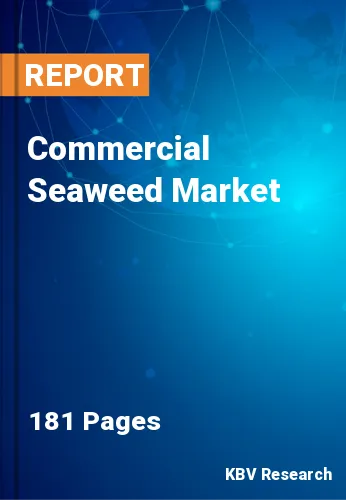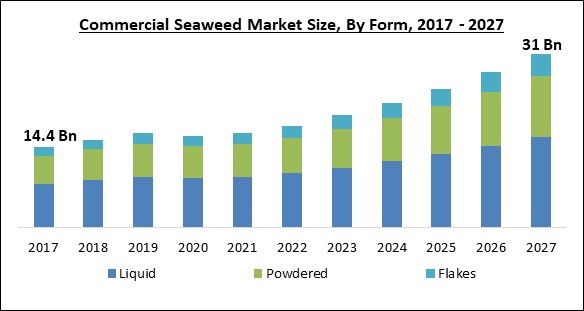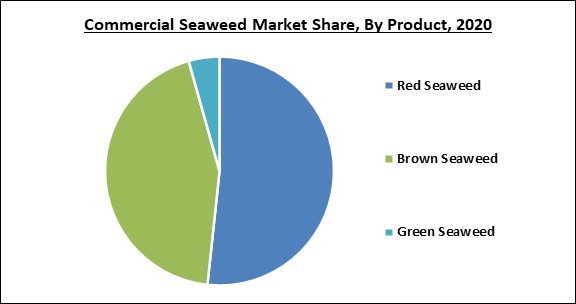
The Global Commercial Seaweed Market size is expected to reach $31 billion by 2027, rising at a market growth of 10.7% CAGR during the forecast period.
Seaweed is the general name for a variety of marine plants and algae that can be found in the ocean, rivers, lakes, and other bodies of water. Some seaweeds, such as phytoplankton, are minuscule and exist floating in the water column, providing the foundation for most marine food chains. Some are massive, including the big kelp that grows in dense forests and tower-like underwater redwoods from their seafloor roots. The majority are medium-sized seaweeds are found in red, green, brown, and black colors, and wash up on beaches and shorelines all over the world.
Several species of macroscopic, marine, and multicellular algae are referred to as seaweed or macroalgae. Rhodophyta (red), Phaeophyta (brown), and Chlorophyta (green) macroalgae are three species of seaweed that can be found across the world. Kelps and other seaweed species provide vital nursery habitats for fisheries and various other marine creatures by protecting their food sources. Seaweeds are vital for a variety of aquatic organisms, both as habitat and as food, and they also provide numerous benefits to land residents, particularly humans.
Seaweed extracts are products that are used in various sectors like food, agriculture, cosmetics, and pharmaceuticals. The application of these seaweed extracts may differ in various industries. The agriculture sector uses seaweed as a component in pesticides, horticulture, and fertilizers. The food industry utilizes seaweed extracts for making diverse snacks because of its health benefits. In addition, seaweed extracts help in reducing the cholesterol level, improving digestion, and weight loss which makes it an important and effective part of dietary food.
Brown seaweeds are a good source of iodine, which is rare in other foods or ingredients. In addition, controlling the levels of estradiol and estrogen in the human body is also a key benefit of brown seaweeds. For human feeding trials that aid in the creation of anti-obesity meals, the use of seaweed and its isolates can increase satiety while also lowering the postprandial rate of absorption of glucose and lipids. Seaweed is also a key component in the development of novel culinary products.

The outbreak of the COVID-19 pandemic caused severe harm to the world economy. The diffusion of the pandemic substantially impacted all businesses across the world. Moreover, in order to stop the spread of the novel coronavirus, governments across the world had to impose a lockdown, due to which, all the industries were temporarily shut. The pandemic also notably affected the commercial seaweed market.
Because of the widespread of the COVID-19 pandemic, the market's exponential growth was decreased in 2020. Due to travel limitations in the majority of the primary seaweed-producing countries, the trade of seaweed decreased dramatically. In addition, owing to the restriction of international trade and international borders to prevent the spread of coronavirus around the world, seaweed shipments to key demand countries suffered a steep downfall.
As seaweed grows, it absorbs carbon dioxide and can be used as a source of biomass for energy production. The seaweed is crushed first, then water is added into it to make a slurry with the crushed seaweed. Further, fermentation is carried out with the help of microorganisms in order to produce methane. The methane gas that is produced through the fermentation process is utilized as a fuel in gas engines that generate electricity. Moreover, it is also utilized in wastewater management and has two applications in this sector. The first is to treat sewage and some agricultural wastes to minimize total nitrogen and phosphorus-containing substances before releasing them into rivers or oceans. The second is for harmful metal removal from industrial effluent.
Seaweed farming is becoming an alternative occupation in tropical developing nations to enhance the socio-economic status of small and medium-scale fishermen, boost the standard of living of the coastal population, and promote the sustainable use of coastal and marine resources. Seaweeds also have a faster growth rate and do not need fresh water or significant land space. They also do not necessitate the use of environmentally harmful industrial fertilizers and pesticides. As a result, cost-effective harvesting procedures and the ease in the cultivation of seaweeds would attract more farmers to do seaweed farming.
A major element driving the utilization of commercial seaweeds is the large volume of cultivation related to sea vegetables, as well as the reduced cost of production. Farmers are opting for seaweed production due to the commercial feasibility of the product.
The cultivation and processing of seaweed partially rely on the condition of the climate. Favorable climate condition is one of the major factors that play a crucial role in the efficient production of seaweed. Due to this, a significant challenge for the market players across the seaweed is the occurrence of natural calamities. In addition, these climate conditions majorly affect seaweed producers, especially near coastal areas. In these areas, the occurrence of disasters, such as floods and typhoons, is very common. These disasters can demolish all the seaweed crops.
Moreover, in other areas, a major challenge for the producers is to safeguard their crops from pests, which can substantially damage crops. Additionally, other natural calamities, including droughts, earthquakes, and pandemics, can also reduce the productivity of seaweed farming. Further, alternative cultivation techniques, such as building artificial ponds away from marine areas, are very costly.

Based on Product, the market is segmented into Red Seaweed, Brown Seaweed, and Green Seaweed. In 2020, the red seaweed segment acquired the largest revenue share of the commercial seaweed market. The growth of the segment is attributed to the excellent functional attributes of the product. Red seaweeds are leveraged as food crops as they are rich in proteins and vitamins. In addition, red seaweeds are being extensively utilized in food preparations and are an excellent source of agar and kappa carrageenan.
Based on Application, the market is segmented into Human Consumption, Agriculture Animal Feed, and Others. In 2020, the agriculture segment recorded a significant revenue share of the commercial seaweed market. The increase in the utilization of seaweed across the agricultural sector is owing to various factors that are associated with the product, including liming properties, the ability to increase phycocolloids improve soil structure and enhancing biological activities.
Based on Form, the market is segmented into Liquid, Powdered, and Flakes. In 2020, the liquid segment procured the maximum revenue share of the commercial seaweed market. The liquid seaweed is majorly utilized for the nourishment of plants. It comprises various hormones, such as Cytokinins, Auxins, and Gibberellins, which can stimulate the natural growth of the plants. In addition, it also contains various minerals, enzymes, and vitamins that can help in the natural growth of plants.
| Report Attribute | Details |
|---|---|
| Market size value in 2020 | USD 16.4 Billion |
| Market size forecast in 2027 | USD 31 Billion |
| Base Year | 2020 |
| Historical Period | 2017 to 2019 |
| Forecast Period | 2021 to 2027 |
| Revenue Growth Rate | CAGR of 10.7% from 2021 to 2027 |
| Number of Pages | 181 |
| Number of Tables | 360 |
| Report coverage | Market Trends, Revenue Estimation and Forecast, Segmentation Analysis, Regional and Country Breakdown, Companies Strategic Developments, Company Profiling |
| Segments covered | Product, Form, Application, Region |
| Country scope | US, Canada, Mexico, Germany, UK, France, Russia, Spain, Italy, China, Japan, India, South Korea, Singapore, Malaysia, Brazil, Argentina, UAE, Saudi Arabia, South Africa, Nigeria |
| Growth Drivers |
|
| Restraints |
|
Based on Regions, the market is segmented into North America, Europe, Asia Pacific, and Latin America, Middle East & Africa. In 2020, Asia-Pacific acquired the largest revenue share of the commercial seaweed market. In countries like China and Japan, seaweeds are mostly eaten in the raw form or utilized in food preparations. Moreover, seaweed is majorly being cultivated due to the higher availability of labor at very low costs in the region. The employment rates of these countries are low due to the increased population. Due to this, seaweed cultivation is expediting across this region.
Free Valuable Insights: Global Commercial Seaweed Market size to reach USD 31 Billion by 2027
The market research report covers the analysis of key stake holders of the market. Key companies profiled in the report include DuPont de Nemours, Inc., Groupe Roullier, Brandt, Inc., Acadian Seaplants Limited, Indigrow Ltd., COMPO Group, Seasol International Pty Ltd., Gelymar SA (Algina Inversiones SA), Cargill Corporation, and Biostadt India Ltd.
By Product
By Application
By Form
By Geography
The global commercial seaweed market size is expected to reach $31 billion by 2027.
Increasing seaweed farming activities across the world are driving the market in coming years, however, Risk of natural calamities limited the growth of the market.
DuPont de Nemours, Inc., Groupe Roullier, Brandt, Inc., Acadian Seaplants Limited, Indigrow Ltd., COMPO Group, Seasol International Pty Ltd., Gelymar SA (Algina Inversiones SA), Cargill Corporation, and Biostadt India Ltd.
The Human Consumption segment has acquired maximum revenue share of Global Commercial Seaweed Market by Application in 2020 thereby, achieving a market value of $25.1 billion by 2027.
The Asia Pacific market is the fastest growing region in the Global Commercial Seaweed Market by Region in 2020, and would continue to be a dominant market till 2027.
Our team of dedicated experts can provide you with attractive expansion opportunities for your business.
